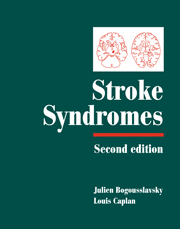Book contents
- Frontmatter
- Contents
- List of contributors
- Preface
- PART I CLINICAL MANIFESTATIONS
- PART II VASCULAR TOPOGRAPHIC SYNDROMES
- 29 Arterial territories of human brain
- 30 Superficial middle cerebral artery syndromes
- 31 Lenticulostriate arteries
- 32 Anterior cerebral artery
- 33 Anterior choroidal artery territory infarcts
- 34 Thalamic infarcts and hemorrhages
- 35 Caudate infarcts and hemorrhages
- 36 Posterior cerebral artery
- 37 Large and panhemispheric infarcts
- 38 Multiple, multilevel and bihemispheric infarcts
- 39 Midbrain infarcts
- 40 Pontine infarcts and hemorrhages
- 41 Medullary infarcts and hemorrhages
- 42 Cerebellar stroke syndromes
- 43 Extended infarcts in the posterior circulation (brainstem/cerebellum)
- 44 Border zone infarcts
- 45 Classical lacunar syndromes
- 46 Putaminal hemorrhages
- 47 Lobar hemorrhages
- 48 Intraventricular hemorrhages
- 49 Subarachnoid hemorrhage syndromes
- 50 Brain venous thrombosis syndromes
- 51 Carotid occlusion syndromes
- 52 Cervical artery dissection syndromes
- 53 Syndromes related to large artery thromboembolism within the vertebrobasilar system
- 54 Spinal stroke syndromes
- Index
- Plate section
53 - Syndromes related to large artery thromboembolism within the vertebrobasilar system
from PART II - VASCULAR TOPOGRAPHIC SYNDROMES
Published online by Cambridge University Press: 17 May 2010
- Frontmatter
- Contents
- List of contributors
- Preface
- PART I CLINICAL MANIFESTATIONS
- PART II VASCULAR TOPOGRAPHIC SYNDROMES
- 29 Arterial territories of human brain
- 30 Superficial middle cerebral artery syndromes
- 31 Lenticulostriate arteries
- 32 Anterior cerebral artery
- 33 Anterior choroidal artery territory infarcts
- 34 Thalamic infarcts and hemorrhages
- 35 Caudate infarcts and hemorrhages
- 36 Posterior cerebral artery
- 37 Large and panhemispheric infarcts
- 38 Multiple, multilevel and bihemispheric infarcts
- 39 Midbrain infarcts
- 40 Pontine infarcts and hemorrhages
- 41 Medullary infarcts and hemorrhages
- 42 Cerebellar stroke syndromes
- 43 Extended infarcts in the posterior circulation (brainstem/cerebellum)
- 44 Border zone infarcts
- 45 Classical lacunar syndromes
- 46 Putaminal hemorrhages
- 47 Lobar hemorrhages
- 48 Intraventricular hemorrhages
- 49 Subarachnoid hemorrhage syndromes
- 50 Brain venous thrombosis syndromes
- 51 Carotid occlusion syndromes
- 52 Cervical artery dissection syndromes
- 53 Syndromes related to large artery thromboembolism within the vertebrobasilar system
- 54 Spinal stroke syndromes
- Index
- Plate section
Summary
Commonest location of arterial lesions
The most common vascular lesion that causes posterior circulation infarction is located within the proximal portions of the extracranial vertebral arteries (ECVAs) (Caplan 1996). Atherosclerosis most often affects the first few centimetres of the ECVAs after their origin from the subclavian arteries (Hutchinson & Yates, 1956; Caplan, 1996). Sometimes plaques extend from the subclavian arteries into the proximal ECVAs. Occlusive lesions at this site are most common in white men (Gorelick et al., 1985; Caplan, 1996). Hypertension, hypercholesterolemia, coronary artery disease, peripheral vascular occlusive disease, and atherostenotic lesions in the proximal internal carotid arteries often accompany the ECVA lesions (Gorelick et al., 1985; Caplan, 1996; Yates & Hutchinson, 1957). Black people, Asians and women less often have occlusive ECVA disease. ECVA lesions cause transient hypoperfusion. The major mechanism of posterior circulation infarction, in patients with ECVA atherosclerosis, is intra-arterial embolism (Caplan, 1991, 1996; Caplan et al., 1992; Caplan & Tettenborn 1992a; Wityk et al., 1998).
Atherosclerosis is unusual in the portion of the ECVA that traverses the transverse foramena or in the distal portions of the ECVA before dural penetration. The predominant lesion within the second and third portions of the ECVA is dissection (Caplan et al., 1985; Caplan & Tettenborn, 1992b; Chiras et al., 1985; Mas et al., 1987; Mokri et al., 1988). Dissections that involve the distal ECVA sometimes extend into the intracranial vertebral artery (ICVA). Thrombus within the lumen of the dissected artery may propagate into the ICVA or embolize intracranially to cause infarction.
- Type
- Chapter
- Information
- Stroke Syndromes , pp. 667 - 690Publisher: Cambridge University PressPrint publication year: 2001



